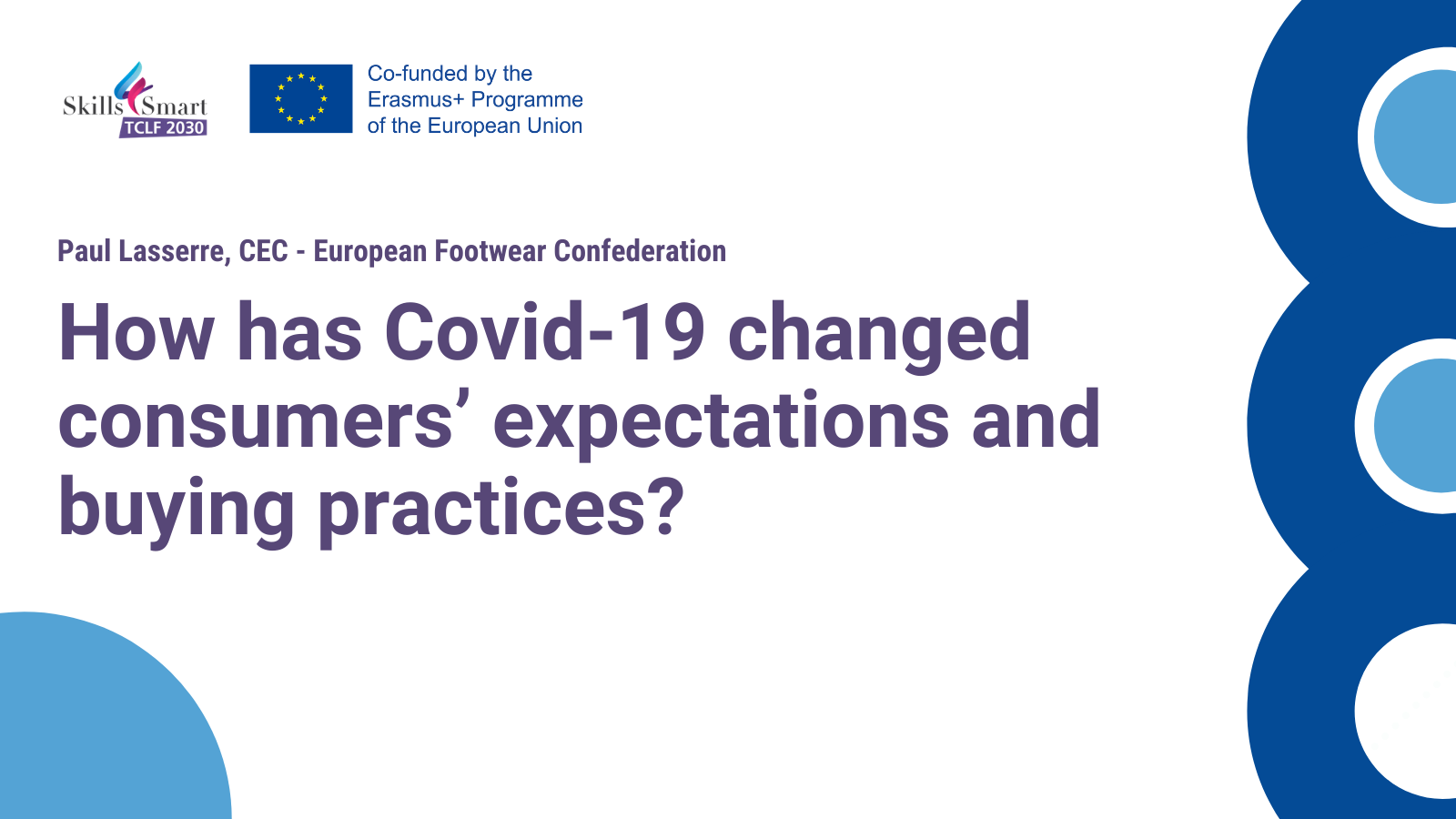COVID-19 deeply changed consumer behaviour. With the right skills and opportune approach TCLF companies can benefit from it.
The scale and length of the COVID-19 sanitary and economic crisis have had a profound impact on everyone’s lives. Millions of people have been asked to stay at home to slow down the pandemic. In Europe, government health and safety measures have incurred the closing of workplaces, schools, and many businesses. The ensuing economic downturn has negatively affected the finances of many Europeans, and the enduring lockdowns have incurred drastic lifestyle changes. A combination of economic uncertainty and lifestyle changes have changed what and how people consume, and Textile, Clothing, Leather, and Footwear (TCLF) have been among the hardest-hit sectors. How have consumers changed, and what does it mean for TCLF companies in Europe?
Economic downturn and focus on basic needs
The vast majority of surveys conducted since the onset of the pandemic show that it has undoubtedly affected peoples’ consumption behaviour. Income losses and lack of optimism in an economic recovery have resulted in a decrease in spending. The European Consumer Conditions Survey 2021 found out that 38% of Europeans were concerned about paying their bills the following month and that 42% considered postponing a major purchase due to the crisis[1]. With economic uncertainty, reduced hours at work and fear of losing a job, consumers are more mindful of their spending. They are cutting down on certain categories of goods, shopping less frequently, and only buying the essentials.
Lifestyle changes and decline in demand
Work-from-home orders, no social and cultural gatherings, and travel restrictions have also completely influenced consumers’ needs for certain products. A McKinsey & Co survey shows that consumers from France, Germany, Spain and Italy are anticipating spending 49% to 30% less on products such as Footwear, Apparel, Accessories or Home Furnishing[2]. With no need to dress up to go to the office, more time spent at home, and fewer international tourists in European capitals, the demand for TCLF fashion products has sharply declined. The case of Footwear is a perfect illustration of the impact of lifestyle changes on demand: sales of dress shoes have decreased in high numbers, while sport shoes and home-worn shoes – such as slippers – have experienced higher-than-usual sales. Similarly, clothing brands have witnessed a rise in casual clothing and sportswear sales.
New values
In addition to cutting spending and to shifting their attention to new categories of products, consumers are also looking at products through a new lens. Studies have found out that for European consumers, the main reasons to choose a new brand are value, availability and quality/organic nature[3]. Sustainability and local production have also become important criteria when making a purchase decision: 56% of Europeans said that environmental concerns influenced their purchasing decisions and 67% said that they bought products that were better for the environment, even if such products were more expensive. Another 81% of Europeans declared shopping closer to home and supporting local businesses[4].
Digital purchase and customer experience
One of the most significant consequences of generalised lockdowns is the shift to online shopping. Eurostat data shows that 62% of Europeans with internet access bought goods or services online in 2015. In 2020, the value went up to 72%[5]. However, this increase does not compensate for the losses in physical retail, which is still a beloved way of shopping for TLCF products and represents about 75% of total sales[6]. The McKinsey & Co and Business of Fashion 2021 “State of Fashion 2021” report shows that both businesses and consumers have jumped 5 years forward in adopting digital commerce in a matter of months. In addition to purchasing, both consumers and companies have become accustomed to and embraced virtual customer service, live streams and other forms of online customer experience[7]. But the shift to digital commerce has been quite rocky for many European TCLF companies at first, as many small companies were unprepared to manage the sheer number of internet transactions and unable to provide appropriate e-shop services.
Despite Covid-induced hardships, companies can improve and sustain their competitiveness by investing in upskilling and reskilling their workforce to be able to turn these challenges into opportunities. Digitalisation, including eCommerce, are creating new ways to set up efficient digital strategies and attract new consumers. Sustainability is gaining momentum and becoming economically attractive, and competitive companies have an opportunity to seize market shares from their peers and expand their operations. Companies that possess employees and workers with the right set of skills will be able to build up effective digital strategies, set up new business models, digitise their processes and come up with more sustainable production processes to effectively respond to these new consumer demands. Government recovery funds can provide financial support to companies: under the EU Recovery Package, Member States are encouraged to invest in upskilling and reskilling employees and workers, and to ensure that funding is allocated to the right measures to help companies engage in the digital and green transition. Companies should grasp such opportunities to reinforce their strengths and successfully react to this new reality.
Author: Paul Lasserre / CEC
Ressources
[1] European Commission and IPSOS. 2021. Consumer Conditions Survey: Consumers at home in
the single market – 2021 edition. Online : https://ec.europa.eu/info/policies/consumers/consumer-protection/key-consumer-data_en
[2] McKinsey & Company. 2021. Consumer sentiment and behavior continue to reflect the uncertainty of the COVID-19 crisis. Online: https://www.mckinsey.com/business-functions/marketing-and-sales/our-insights/a-global-view-of-how-consumer-behavior-is-changing-amid-covid-19n
[3] McKinsey & Company. 2021. Consumer sentiment and behavior continue to reflect the uncertainty of the COVID-19 crisis. Online: https://www.mckinsey.com/business-functions/marketing-and-sales/our-insights/a-global-view-of-how-consumer-behavior-is-changing-amid-covid-19n
[4] European Commission and IPSOS. 2021. Consumer Conditions Survey: Consumers at home in
the single market – 2021 edition. Online : https://ec.europa.eu/info/policies/consumers/consumer-protection/key-consumer-data_en
[5] Eurostat. 2021. Online shopping ever more popular in 2020. Online: https://ec.europa.eu/eurostat/web/products-eurostat-news/-/ddn-20210217-1
[6] Schnure, Calvin – Forbes. 2021. Brick-And-Mortar Retail Is Bouncing Back. Online: https://www.forbes.com/sites/calvinschnure/2021/03/18/brick-and-mortar-retail-is-bouncing-back/?sh=3aeaef15d0f4
[7] Mc Kinsey & Company and the Business of Fashion. The State of Fashion 2021. Online: https://www.mckinsey.com/~/media/McKinsey/Industries/Retail/Our%20Insights/State%20of%20fashion/2021/The-State-of-Fashion-2021-vF.pdf


